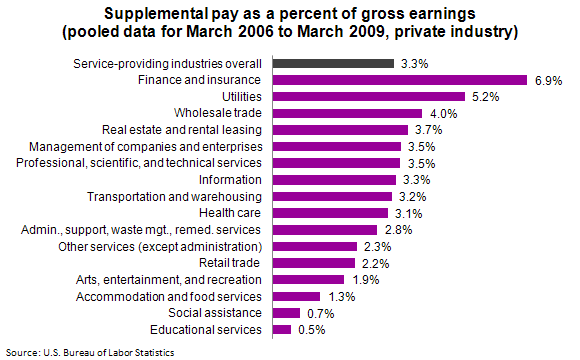April 27, 2010 (The Editor’s Desk is updated each business day.)
Supplemental pay in the finance and insurance industry
Over the period from 2006 to 2009, supplemental pay—overtime, bonuses, and shift differentials combined—accounted for 6.9 percent of gross earnings in finance and insurance, compared with 3.3 percent for the service-providing sector overall.

[Chart data]
Finance and insurance is among the industries that pay the highest percentage of gross earnings in the form of supplemental pay, along with utilities (5.2 percent) and wholesale trade (4.0 percent). Industries for which supplemental pay makes up a considerably smaller percentage of gross earnings include educational services (0.5 percent), accommodation and food services (1.3 percent), and retail trade (2.2 percent).
Among the components of supplemental pay, the percentage of gross earnings received as bonuses is greater for finance and insurance (6.5 percent) than it is for other service-providing industries (1.4 percent). The percentage for overtime and shift differentials is smaller for finance and insurance than it is for the other service-providing industries.
These data are from the National Compensation Survey. The data are pooled from 2006 to 2009 using the first quarter of data for each year. Supplemental pay differs from benefits such as health or life insurance in that the employee receives it as a cash payment. To learn more, see "Supplemental Pay in the Finance and Insurance Industry" (HTML), Compensation and Working Conditions Online, April 2010.
Related TED articles
Benefits |
Earnings and wages |
Industry studies
Of interest
Spotlight on Statistics: National Hispanic Heritage Month
In this Spotlight, we take a look at the Hispanic labor force—including labor force participation, employment and unemployment, educational attainment, geographic location, country of birth, earnings, consumer expenditures, time use, workplace injuries, and employment projections.
.
Read more »
